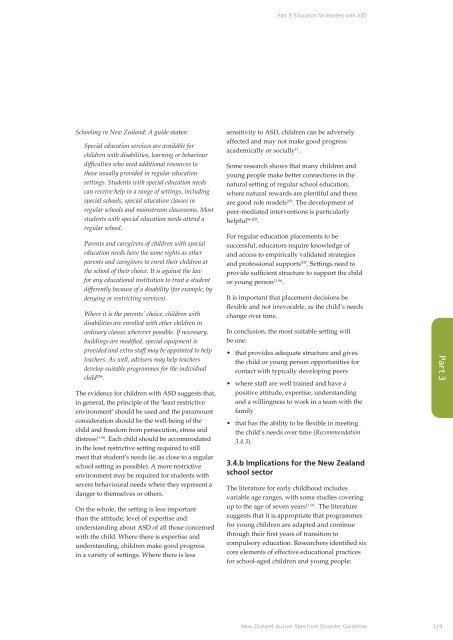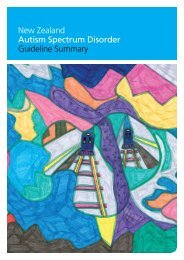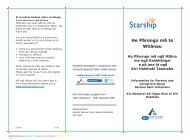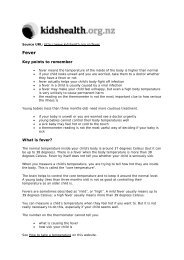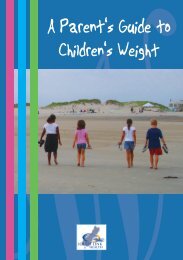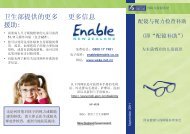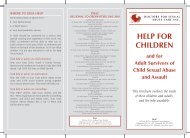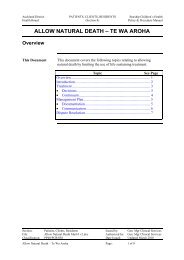New Zealand Autism Spectrum Disorder Guideline - Ministry of Health
New Zealand Autism Spectrum Disorder Guideline - Ministry of Health
New Zealand Autism Spectrum Disorder Guideline - Ministry of Health
Create successful ePaper yourself
Turn your PDF publications into a flip-book with our unique Google optimized e-Paper software.
Part 3: Education for learners with ASD<br />
Schooling in <strong>New</strong> <strong>Zealand</strong>: A guide states:<br />
Special education services are available for<br />
children with disabilities, learning or behaviour<br />
difficulties who need additional resources to<br />
those usually provided in regular education<br />
settings. Students with special education needs<br />
can receive help in a range <strong>of</strong> settings, including<br />
special schools, special education classes in<br />
regular schools and mainstream classrooms. Most<br />
students with special education needs attend a<br />
regular school.<br />
Parents and caregivers <strong>of</strong> children with special<br />
education needs have the same rights as other<br />
parents and caregivers to enrol their children at<br />
the school <strong>of</strong> their choice. It is against the law<br />
for any educational institution to treat a student<br />
differently because <strong>of</strong> a disability (for example, by<br />
denying or restricting services).<br />
Where it is the parents’ choice, children with<br />
disabilities are enrolled with other children in<br />
ordinary classes wherever possible. If necessary,<br />
buildings are modified, special equipment is<br />
provided and extra staff may be appointed to help<br />
teachers. As well, advisers may help teachers<br />
develop suitable programmes for the individual<br />
child 256 .<br />
The evidence for children with ASD suggests that,<br />
in general, the principle <strong>of</strong> the ‘least restrictive<br />
environment’ should be used and the paramount<br />
consideration should be the well-being <strong>of</strong> the<br />
child and freedom from persecution, stress and<br />
distress 11 96 . Each child should be accommodated<br />
in the least restrictive setting required to still<br />
meet that student’s needs (ie, as close to a regular<br />
school setting as possible). A more restrictive<br />
environment may be required for students with<br />
severe behavioural needs where they represent a<br />
danger to themselves or others.<br />
On the whole, the setting is less important<br />
than the attitude, level <strong>of</strong> expertise and<br />
understanding about ASD <strong>of</strong> all those concerned<br />
with the child. Where there is expertise and<br />
understanding, children make good progress<br />
in a variety <strong>of</strong> settings. Where there is less<br />
sensitivity to ASD, children can be adversely<br />
affected and may not make good progress<br />
academically or socially 11 .<br />
Some research shows that many children and<br />
young people make better connections in the<br />
natural setting <strong>of</strong> regular school education,<br />
where natural rewards are plentiful and there<br />
are good role models 255 . The development <strong>of</strong><br />
peer-mediated interventions is particularly<br />
helpful 96 203 .<br />
For regular education placements to be<br />
successful, educators require knowledge <strong>of</strong><br />
and access to empirically validated strategies<br />
and pr<strong>of</strong>essional supports 247 . Settings need to<br />
provide sufficient structure to support the child<br />
or young person 11 96 .<br />
It is important that placement decisions be<br />
flexible and not irrevocable, as the child’s needs<br />
change over time.<br />
In conclusion, the most suitable setting will<br />
be one:<br />
• that provides adequate structure and gives<br />
the child or young person opportunities for<br />
contact with typically developing peers<br />
• where staff are well trained and have a<br />
positive attitude, expertise, understanding<br />
and a willingness to work in a team with the<br />
family<br />
• that has the ability to be flexible in meeting<br />
the child’s needs over time (Recommendation<br />
3.4.3).<br />
3.4.b Implications for the <strong>New</strong> <strong>Zealand</strong><br />
school sector<br />
The literature for early childhood includes<br />
variable age ranges, with some studies covering<br />
up to the age <strong>of</strong> seven years 11 96 . The literature<br />
suggests that it is appropriate that programmes<br />
for young children are adapted and continue<br />
through their first years <strong>of</strong> transition to<br />
compulsory education. Researchers identified six<br />
core elements <strong>of</strong> effective educational practices<br />
for school-aged children and young people:<br />
Part 3<br />
<strong>New</strong> <strong>Zealand</strong> <strong>Autism</strong> <strong>Spectrum</strong> <strong>Disorder</strong> <strong>Guideline</strong> 129


